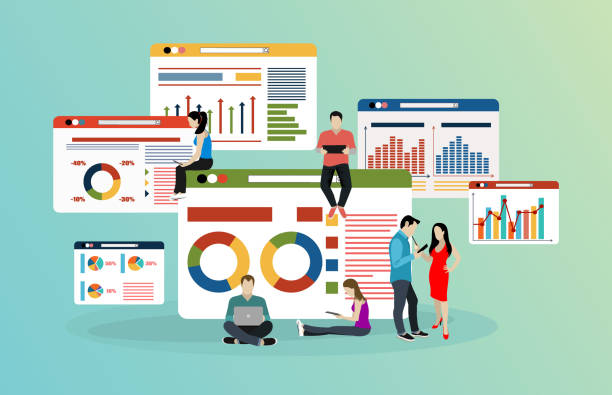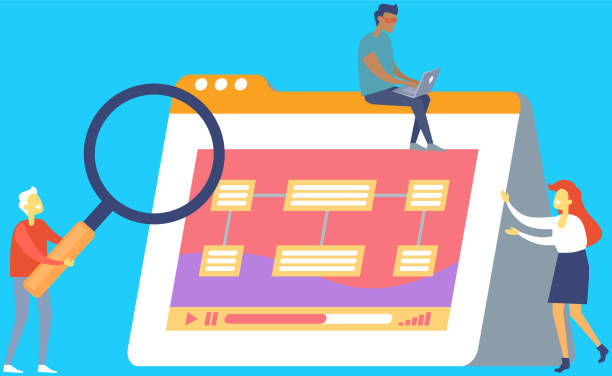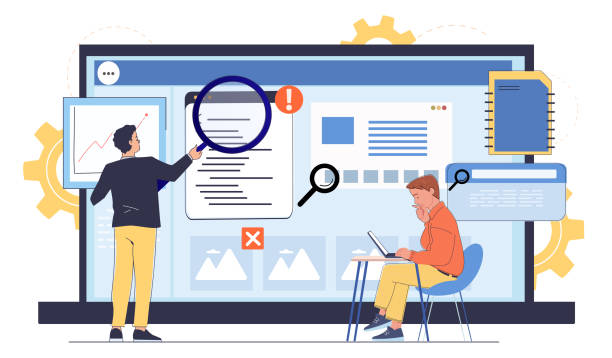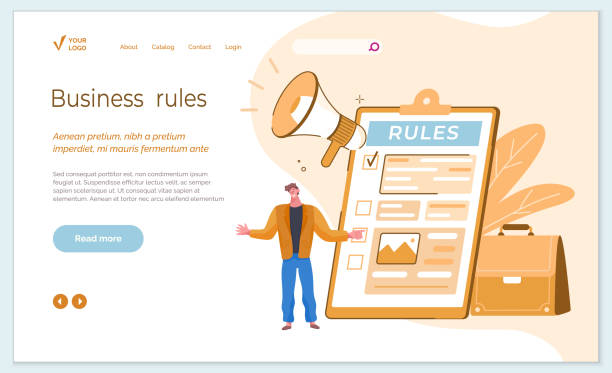Introduction to the Importance of Multilingual Website Design in the Digital Age

In today’s world, where geographical boundaries have less meaning in virtual space and digital marketing is the beating heart of every business, #multilingual_website_design is no longer a luxury option but a strategic necessity for any business seeking #global_expansion, #attracting_more_audiences, and establishing a powerful international presence.
This advanced approach allows you to deliver your brand message, products, or services in the native language of users from different cultures and regions, thereby establishing deeper and more meaningful connections with them.
Imagine you are a software company and intend to offer your tools not only in the domestic market but also in European, Asian, or Latin American countries.
Without multilingual capabilities on your website, you will practically miss out on a unique opportunity to enter emerging markets and increase market share.
The goal of multilingual website design is not merely content translation; it goes beyond that to include cultural adaptability, special attention to international SEO (Search Engine Optimization), and providing a seamless and desirable user experience for all visitors, regardless of their language and nationality.
When a user from another country visits your site and can see content, menus, and even contact forms in their own language, their sense of trust, comfort, and satisfaction significantly increases.
This not only significantly helps in increasing the conversion rate but also makes visitors spend more time on your site, engage with your content, and increases the likelihood of their return to the site.
Thus, multilingual website design plays an irreplaceable role in building a powerful, recognized, and trusted international brand.
This approach is particularly vital for companies whose services or products have the potential for global market penetration.
From large multinational corporations seeking deeper penetration into new markets to small and medium-sized startups that want to globalize their business from day one, all can benefit from the countless advantages of having a website capable of displaying in multiple languages.
This strategic move not only expands your access to new customers but also helps you compete more effectively with international competitors and increase your share of the global market.
This process is an investment for the future that will yield a high return on investment.
Are you tired of your company’s website not getting the visibility it deserves and losing potential customers? Solve this problem forever with professional and effective website design by Rasawp!
✅ Increase brand credibility and gain customer trust
✅ Attract targeted sales leads
⚡ Contact us now for a free consultation!
Key Points and Planning for Successful Multilingual Website Implementation

To start the multilingual website design process, precise planning, thorough research, and attention to the smallest details are of paramount importance.
The first and most crucial step is to determine the languages in which you intend to offer your website.
This choice should not be random; instead, it should be based on in-depth market research, precise target audience analysis, examination of global trends, and the growth potential of your business in different geographical regions.
Is a significant portion of your potential audience in Arabic-speaking countries or in the booming Chinese market? Are Spanish or German languages particularly important for expanding your business activities in Europe? After selecting the languages, you need to consider how you will produce, translate, edit, and manage the content.
Using native, expert, and experienced translators in your field of activity is crucial, as they not only have full command of the target language’s nuances and complexities but also are sufficiently familiar with the culture, common idioms, and specific sensitivities of each geographical region.
Machine translation, although it has made significant progress in recent years, usually lacks the necessary quality and cultural accuracy required for professional and impactful content and may seriously damage your brand’s reputation.
Another very important aspect in planning for implementing a multilingual website is choosing a suitable Content Management System (CMS) that supports multilingual capabilities in the best possible way and provides the necessary flexibility for future developments.
Platforms like WordPress, using powerful plugins such as WPML or Polylang, or more robust and scalable systems like Drupal or Jahngas CMS, provide the necessary tools for managing and organizing different website languages.
You also need to pay special attention to URL structures; will you use subdomains (e.g., en.yoursite.com), subfolders (e.g., yoursite.com/en), or URL parameters (e.g., yoursite.com?lang=en)? Each of these methods has its own advantages and disadvantages in terms of SEO (Search Engine Optimization) and should be chosen carefully based on long-term business goals.
Successful multilingual website design requires a comprehensive and strategic approach that meticulously covers all technical, content, and marketing dimensions from the initial planning and research stages to implementation, launch, and maintenance, to achieve optimal, efficient, and sustainable results and help expand your business’s reach in global markets.
Technical and Architectural Aspects in Multilingual Website Design

When designing a multilingual website, choosing the correct technical architecture for your website platform is of immense importance and can directly impact your site’s performance, scalability, and ease of maintenance in the future.
One of the first and most important decisions relates to the choice of Content Management System (CMS).
Some CMSs are designed from the ground up with native and powerful multilingual support, which greatly simplifies the process, while others require the installation of plugins, modules, and more complex configurations.
For example, WordPress, with plugins like WPML or Polylang, provides the ability to manage content in different languages, but for very large, complex projects with custom requirements, it may need more developed and specific solutions.
Drupal and Joomla are also powerful and flexible platforms with advanced multilingual capabilities that are suitable options for enterprise and large-scale projects.
CMS selection should be based on the team’s technical knowledge, project budget, and forward-looking business requirements.
URL structure is also a strategic technical decision that directly affects SEO and user experience.
The main options include subdomains (en.example.com), subfolders (example.com/en/), and URL parameters (example.com?lang=en).
Subfolders are often preferred for international SEO because all language versions are located within a single domain, and the main domain’s authority is strengthened, which significantly helps improve the site’s ranking in search engines.
Correct and precise use of hreflang tags in the
These tags are vital for international SEO and prevent the occurrence of duplicate content issues, which can lead to site penalties, so accuracy in their implementation is absolutely essential.
Additionally, it should be noted that all site elements, including images, videos, audio files, interactive forms, and error messages, must also be translatable and localizable.
This part of multilingual website design requires close coordination between the development team, content team, and marketing team to ensure no detail is overlooked and a seamless user experience is provided for all users.
Table 1: Comparison of Language Management Methods in Multilingual Website Design
| Method | Advantages | Disadvantages |
|---|---|---|
| Subdomains (en.example.com) | Complete separation of languages, possibility of separate and custom hosting for each language,
Choosing a unified CMS for all languages can be challenging, why? because each subdomain can, in a way, act as a separate entity and require independent management. |
Need to acquire separate domain authority for each language (in terms of SEO), increased complexity in managing SEO and backlinks. |
| Subfolders (example.com/en/) | Preserves main domain authority across all languages, easier SEO management,
This method is particularly ideal for businesses that want to benefit from local SEO advantages and be better seen in search results relevant to each region, and is recommended by many experts. |
May cause issues for very long URLs, sometimes more precise geographical targeting for search engines is slightly more difficult. |
| URL Parameters (example.com?lang=en) | Simplest and fastest implementation method, high flexibility in changing languages without needing to change URL structure. | Lowest SEO value, may be considered as duplicate content by search engines.
This method is rarely recommended for large, commercial websites with SEO goals and is more suitable for small, experimental, or internal projects. |
Effective Strategies for Content Translation and Localization

The success of a multilingual website design is highly dependent on the quality, accuracy, and depth of content translation and localization.
Simply translating words from one language to another is by no means sufficient; the content must be culturally, linguistically, and even emotionally aligned with the target audience in each region to convey your message correctly and with full impact.
The first step in this regard is to collaborate with specialized native translators who not only have full and native command of the target language but are also familiar with common idioms, subtle cultural differences, and even the local sentiment.
These individuals can ensure that your message is conveyed correctly and without any misunderstanding, and that true localization takes place instead of literal translation.
In addition to translating written texts, localization also includes adapting units (such as currency, date, time, measurement units), images, videos, graphical elements, and even page layout and design to align with the tastes and cultural expectations of each region.
Another important strategy for maintaining content quality and consistency in the multilingual website design process is the use of advanced tools such as Translation Memory (TM) and Terminology Management (TM).
These tools help maintain consistency and stability in translations over time, especially in large projects with high volumes of content and a need for continuous updates.
Translation Memory stores sentences or phrases that have been previously translated, significantly reducing the cost and time of re-translation.
Terminology Management, on the other hand, is a comprehensive list of specialized terms, keywords, and specific phrases in your industry that must be translated consistently across all languages to prevent confusion for users and search engines.
Finally, conducting Localization Testing by real native users before the final launch of the website can greatly help identify and resolve any minor potential issues, cultural discrepancies, or linguistic errors, significantly enhancing the User Experience (UX) for all target audiences worldwide.
This comprehensive and precise approach ensures that your multilingual website design is not only technically powerful but also flawlessly effective in terms of content and culture.
Does your current corporate website not reflect your brand’s credibility and power as it should? Rasawp solves this challenge for you with professional corporate website design.
✅ Increase credibility and trust of visitors
✅ Targeted attraction of more customers
⚡ Click for a free consultation!
Search Engine Optimization (SEO) for Multilingual Websites

Search Engine Optimization (SEO) for a multilingual website has its own complexities and subtleties that must be carefully considered with high technical knowledge to achieve maximum visibility in international search results.
The main goal is for search engines to correctly index different language versions of your site and display them to the appropriate users in search results.
One of the most important and vital tools for achieving this goal is the correct and precise use of the hreflang tag.
These tags are placed in the
Incorrect or incomplete use of hreflang can lead to serious SEO problems, including incorrect indexing of pages, competition between different language versions over common keywords, or even penalties due to duplicate content, so accuracy in its implementation is absolutely essential.
In addition to hreflang, the translated content should be optimized to include appropriate and highly searched keywords for each specific language and region.
This means that simply direct translation of keywords from one language to another is not enough; instead, separate and comprehensive Keyword Research should be conducted for each language, as search queries, search volume, and even user intent differ across languages and require a deep understanding of the local market.
URL structures also directly impact SEO; as mentioned earlier, subfolders (like yoursite.com/es/) are generally recommended for international SEO and maintaining domain authority.
Also, building internal and external links (Internal and External Linking) to different language versions, and ensuring that search engines can easily access and index all your multilingual pages, are other vital aspects.
Multilingual website design should be carried out from the very beginning with all these complex and technical SEO points in mind to ensure maximum visibility in search engines.
Don’t forget that high-quality, unique content tailored to the culture of each language is the foundation of long-term SEO success.
This specialized approach to international SEO can significantly increase your organic traffic and lead to sustainable business growth.
Latest Trends and Technologies in Multilingual Website Design

The web industry is evolving rapidly, and the field of multilingual website design is no exception, constantly witnessing new innovations.
One of the most important current and future-shaping trends is the widespread use of Artificial Intelligence (AI) and Machine Learning (ML) in all stages of the translation and localization process.
While traditional machine translation still has flaws in conveying linguistic and cultural nuances, advanced AI models like Neural Machine Translation (NMT) have become increasingly accurate and natural, capable of providing very high-quality translations, close to human translation.
These technologies are particularly efficient for high volumes of content, initial translations, and speeding up the overall translation process, although in most cases, they still require human review, editing, and final localization to ensure flawless quality.
Another trend that has gained increasing importance is the use of geographical CDNs (Content Delivery Networks) and content delivery strategies based on user location.
CDNs help deliver content faster and more efficiently to users worldwide and can provide the appropriate language version and optimized site based on the user’s geographical location.
This not only significantly improves user experience but also has a positive and direct impact on SEO performance and site loading speed.
Furthermore, the “Headless CMS” approach is gaining increasing popularity, where content is managed independently of the display layer (front-end) and can be easily and flexibly presented in various languages across different platforms and devices (such as classic websites, mobile applications, interactive kiosks, IoT devices).
This approach gives developers more flexibility in multilingual website design and management and enables the creation of innovative user experiences.
Finally, the importance of content personalization based on language, culture, and even user interaction history, beyond simple translation, is increasing.
Websites in the future will be able to dynamically and intelligently change promotional content, product offers, and even the user interface based on each visitor’s cultural and linguistic preferences, which is a big step towards providing an unparalleled and targeted user experience.
These developments have completely changed the landscape of multilingual website design.
Success Stories and Challenges of Multilingual Website Design

Over many years, we have witnessed countless success stories in the field of multilingual website design, each demonstrating the immense potential of this strategic approach for business growth on a global scale.
Large and well-known companies such as Google, Amazon, and Microsoft, all of whom have extensive and complex multilingual websites, are clear examples of businesses that have achieved remarkable success on an unprecedented scale by effectively accessing global markets.
Popular online booking platforms like Booking.com, by offering content and services in dozens of different languages, have managed to become a trusted destination for millions of travelers and tourists worldwide and capture a large share of the global market.
These success stories typically revolve around increased organic traffic, significant improvement in conversion rates, and unprecedented brand strengthening at an international level, inspiring many companies to embark on the path of globalization.
However, multilingual website design is never without challenges and difficulties, and its path will not be smooth.
One of the biggest problems and controversial content in this area is the continuous management and synchronization of content across multiple languages.
Maintaining consistency, regularly updating all language versions, and ensuring the accuracy and integrity of information can be very time-consuming, costly, and require significant human resources.
Another challenge is ensuring high-quality translations and deep cultural localization.
Poor translations, a lack of understanding of cultural differences, or even machine translations published without human review can seriously damage brand credibility and even lead to negative reactions and distrust from users.
Technical issues such as incorrect implementation of hreflang tags, poor site performance due to loading multiple languages, or problems with language switching and the inability to automatically detect the user’s language can also disrupt the user experience and directly negatively impact the site’s SEO.
These issues create controversial and complex content for development, marketing, and content management teams.
Despite these challenges, the long-term strategic advantages of multilingual website design usually outweigh its disadvantages, provided that a strategic, precise, and industry-best-practice approach is adopted.
Table 2: Examples of Challenges and Solutions in Multilingual Website Design
| Challenge | Proposed Solution | Important Note |
|---|---|---|
| Managing high volume of content and synchronizing it in real-time | Using advanced TMS (Translation Management Systems) and Translation Memory (TM).
These systems help automate the translation process, prevent re-translation of repetitive phrases, and enable simultaneous collaboration between teams. |
Requires initial investment in tools, staff training, and integration with existing systems. |
| Low translation quality or insufficient cultural localization | Exclusive collaboration with specialized native translators in the relevant industry, and final content review by native speakers proficient in the target culture.
Choosing an experienced translation team familiar with cultural and linguistic nuances can make a significant difference in the final quality of the content. |
Increased translation costs and need for more time for review and quality control processes. |
| International SEO issues and lack of visibility in search engines | Correct and precise implementation of hreflang tags, comprehensive keyword research for each language, and URL structure optimization in accordance with SEO best practices. | Requires specialized knowledge of international SEO, continuous monitoring of site performance with analytical tools, and ongoing updates.
SEO analysis tools like Google Search Console and Semrush can help in identifying and resolving issues. |
Reviewing Challenges and Rectifying Common Mistakes in Multilingual Website Design

One of the biggest and most prominent challenges in the path of multilingual website design, beyond mere technical translation of words, is a deep attention to the concept of “Localization.”
Many businesses mistakenly believe that word-for-word translation of texts is sufficient to reach and attract international audiences.
However, this simplistic approach can lead to serious cultural misunderstandings, loss of the brand message’s essence, and even, in worse cases, unintentional offense to the audience.
For example, a color or symbol that symbolizes joy, success, or purity in one culture may evoke sadness, bad luck, or even death in another.
Therefore, the fundamental controversial content is how can we prevent these common and costly mistakes and adopt a comprehensive approach to localization? The answer lies in a deep understanding of the audience and collaboration with local experts.
Another common and technical mistake that can severely harm the performance of a multilingual site is overlooking the importance and complexities of international SEO.
Without correct and precise implementation of hreflang tags, conducting local keyword research tailored to each language’s culture, and optimizing the URL structure for search engines, your site may not be visible in international search results and lose valuable organic traffic.
Failing to provide a clear, accessible, and visual language switch option on all website pages, or failing to automatically and intelligently detect the user’s language based on IP or browser settings, can severely disrupt the user experience and force users to leave the site.
Additionally, choosing an unsuitable hosting service or servers that are not optimized for global audiences can drastically slow down site loading speed and negatively impact the bounce rate and, ultimately, SEO ranking.
To address and prevent these challenges, continuous training for technical and content teams, investing in advanced translation and SEO management tools, and close collaboration with localization and international SEO specialists are essential.
Successful multilingual website design requires a comprehensive, proactive, and multifaceted approach that considers all these dimensions to prevent costly problems in the future and provide a flawless user experience for all global audiences.
How much does losing business leads due to an unprofessional website cost you? Solve this problem forever with professional corporate website design by Rasawp!
✅ Increase credibility and trust of potential customers
✅ Easier attraction of new business leads
⚡ Get a free consultation now!
Tools and Platforms for Efficient Multilingual Website Management

Managing a multilingual site, especially when content and languages are expanding, can be a complex and time-consuming process.
However, with the use of appropriate and advanced tools and platforms, this process becomes significantly simpler, more efficient, and more organized.
One of the first and most important choices is the Content Management System (CMS) that offers native multilingual capability or provides powerful support for various languages through plugins and modules.
Popular platforms like WordPress with powerful plugins such as WPML and Polylang, Joomla, Drupal, and e-commerce platforms like Shopify (using multilingual apps) and Magento all offer comprehensive solutions for this purpose.
The choice of CMS should be based on the specific project needs, available budget, technical capabilities of the development team, and the degree of flexibility required for future growth.
In addition to the CMS, Translation Management Systems (TMS) are very powerful tools that dramatically automate and optimize the complex process of translation and localization.
These systems provide advanced features such as Translation Memory (TM) for storing and reusing previous translations, Terminology Management for maintaining consistency of specialized terms, easy and organized collaboration among translators, editors, and reviewers, and seamless integration with the website’s CMS.
Platforms like Smartling, Phrase, Crowdin, and Transifex are examples of popular and well-known TMSs in the industry that help maintain consistency in translations, significantly reduce translation time and costs, and improve the overall quality of multilingual content.
For the critical international SEO section, tools like Ahrefs, Semrush, and Google Search Console play a vital role in monitoring your site’s performance in different languages and identifying and resolving issues related to hreflang or indexing.
Finally, localization testing and quality assurance tools also help you ensure a flawless and error-free user experience across all languages.
Optimized and successful multilingual website design requires a smart combination of these technical and management tools that allow you to publish your content efficiently, with high quality, and on a global scale, and achieve your business goals.
Maintenance and Future-Proofing in Multilingual Website Development

Multilingual website design is not a one-time process that ends with the initial launch; rather, it is a long-term and continuous commitment that requires ongoing maintenance, updates, and management.
Your website content changes regularly, new products are added, blog articles are updated, and new announcements are published.
Every update or new content added to the site must be accurately and completely translated and localized into all supported languages.
This includes updating product information, blog articles, announcements, landing pages, and even small changes in the user interface and system messages.
Establishing a clear and efficient workflow for managing translations and ensuring complete content synchronization across all languages, is crucial for maintaining consistency and preventing discrepancies.
In addition to content updates, the technical aspects of a multilingual site also require continuous monitoring and maintenance.
Ensuring the correct and error-free functioning of hreflang tags, continuous monitoring of site performance in search engines for each language (using tools like Google Search Console), and resolving any technical issues that might affect user experience or SEO are of high importance.
With the rapid advancement of technology and changes in search engine algorithms, newer and better tools for translation management, localization, and SEO optimization are constantly becoming available.
Future-proofing in this area means staying up-to-date with these technologies, continuously evaluating the site’s needs, and preparing its infrastructure to adapt to future changes and innovations.
This could include exploring Headless CMS systems, utilizing AI for further improvement and automation of translation processes, or leveraging more advanced international SEO techniques.
Ultimately, successful multilingual website design is a continuous investment that, with proper maintenance, regular updates, and a forward-looking approach, can yield tremendous returns in global markets and ensure the sustainable success of your business for many years to come.
Frequently Asked Questions
| Question | Answer |
|---|---|
| What is multilingual website design? | It is the design of a website whose content is available to users in several different languages, allowing users to choose their desired language. |
| Why is a multilingual website important? | To reach international audiences, increase website traffic, improve user experience for non-Persian speaking visitors, and expand business into global markets. |
| What are the benefits of having a multilingual website? | Increased international SEO, attracting new customers from different countries, boosting business credibility and professionalism, and reducing bounce rate by providing understandable content. |
| What are the methods for implementing a multilingual website? | Using subfolders (e.g., example.com/en/), subdomains (e.g., en.example.com), or separate top-level domains for each language (e.g., example.com and example.de). |
| Which URL structure is best for international SEO? | Subdirectories (e.g., example.com/en/) are often preferred for SEO due to consolidating the main domain’s authority, although each method has its advantages and disadvantages. |
| How does a multilingual website affect SEO? | By providing content in different languages, the site appears in local search results for those languages, increasing click-through rates and traffic, and improving the overall domain authority of the site. Correct use of hreflang tags is very important. |
| How is content translation managed? | You can use professional translators, machine translation tools (with human editing), or Content Management Systems (CMS) with built-in multilingual capabilities or relevant plugins. |
| What are the common challenges in multilingual website design? | Managing translated content, maintaining design consistency across different languages, compatibility with Right-to-Left (RTL) languages like Persian and Arabic, optimizing SEO for each language, and choosing an appropriate URL structure. |
| How do I manage text direction (LTR/RTL) on a multilingual site? | For Right-to-Left languages (like Persian), you need to apply specific CSS styles to change text direction, element layout, and table direction. Often by using the direction: rtl; property and other related settings. |
| How can users change the site language? | Usually by using a button, dropdown menu, or language selector widget clearly placed in the header or footer of the site. Automatic detection of the user’s browser language and suggesting a language change is also common. |
And other services of RasaWeb advertising agency in the field of advertising
Smart Link Building: An innovative platform for improving customer acquisition by optimizing key pages.
Smart Google Ads: A novel service for increasing website visits by customizing user experience.
Smart Customer Journey Map: An innovative platform for improving customer behavior analysis with a SEO-driven content strategy.
Smart Customer Journey Map: A dedicated service for increasing sales growth based on precise audience targeting.
Smart Marketing Automation: Professional optimization for digital branding using attractive user interface design.
And more than hundreds of other services in the field of internet advertising, advertising consultation and organizational solutions
Internet Advertising | Advertising Strategy | Advertorials
Sources
- The Importance of Multilingual Website Design for International Businesses
- How to Expand Your Business Globally with a Multilingual Website
- Comprehensive Guide to Multilingual Site Optimization
- Key Tips for Choosing the Right Platform for a Multilingual Site
⚡ Are you ready to take your business to new heights in the digital space? Rasawp Afarin Digital Marketing Agency, with years of experience in providing innovative solutions, including WordPress website design, SEO, and advertising campaign management, is your partner on the path to success. With us, your business future is brighter.
📍 Tehran, Mirdamad Street, next to Bank Markazi, Kazeroon Jonubi Alley, Ramin Alley, Plaque 6



